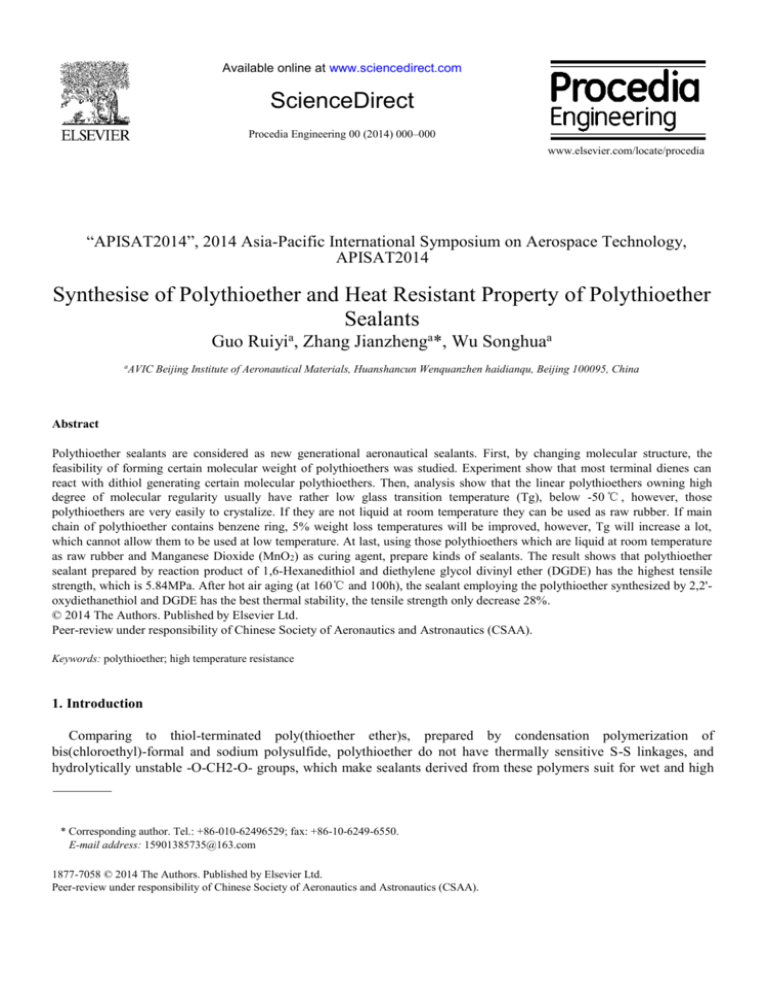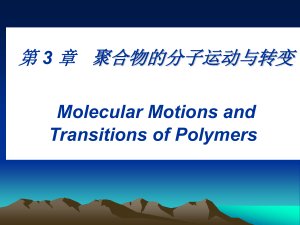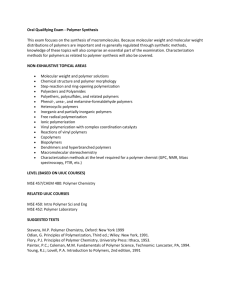173
advertisement

Available online at www.sciencedirect.com ScienceDirect Procedia Engineering 00 (2014) 000–000 www.elsevier.com/locate/procedia “APISAT2014”, 2014 Asia-Pacific International Symposium on Aerospace Technology, APISAT2014 Synthesise of Polythioether and Heat Resistant Property of Polythioether Sealants Guo Ruiyia, Zhang Jianzhenga*, Wu Songhuaa a AVIC Beijing Institute of Aeronautical Materials, Huanshancun Wenquanzhen haidianqu, Beijing 100095, China Abstract Polythioether sealants are considered as new generational aeronautical sealants. First, by changing molecular structure, the feasibility of forming certain molecular weight of polythioethers was studied. Experiment show that most terminal dienes can react with dithiol generating certain molecular polythioethers. Then, analysis show that the linear polythioethers owning high degree of molecular regularity usually have rather low glass transition temperature (Tg), below -50 ℃ , however, those polythioethers are very easily to crystalize. If they are not liquid at room temperature they can be used as raw rubber. If main chain of polythioether contains benzene ring, 5% weight loss temperatures will be improved, however, Tg will increase a lot, which cannot allow them to be used at low temperature. At last, using those polythioethers which are liquid at room temperature as raw rubber and Manganese Dioxide (MnO2) as curing agent, prepare kinds of sealants. The result shows that polythioether sealant prepared by reaction product of 1,6-Hexanedithiol and diethylene glycol divinyl ether (DGDE) has the highest tensile strength, which is 5.84MPa. After hot air aging (at 160℃ and 100h), the sealant employing the polythioether synthesized by 2,2'oxydiethanethiol and DGDE has the best thermal stability, the tensile strength only decrease 28%. © 2014 The Authors. Published by Elsevier Ltd. Peer-review under responsibility of Chinese Society of Aeronautics and Astronautics (CSAA). Keywords: polythioether; high temperature resistance 1. Introduction Comparing to thiol-terminated poly(thioether ether)s, prepared by condensation polymerization of bis(chloroethyl)-formal and sodium polysulfide, polythioether do not have thermally sensitive S-S linkages, and hydrolytically unstable -O-CH2-O- groups, which make sealants derived from these polymers suit for wet and high * Corresponding author. Tel.: +86-010-62496529; fax: +86-10-6249-6550. E-mail address: 15901385735@163.com 1877-7058 © 2014 The Authors. Published by Elsevier Ltd. Peer-review under responsibility of Chinese Society of Aeronautics and Astronautics (CSAA). 2 Gruo Ruiyi/ Procedia Engineering 00 (2014) 000–000 temperature applications.[1] There are two ways to synthesize polythioether, condensation polymerization[2] and addition polymerization[3]. Condensation polymerization can be catalyzed by acid or base. Acid-catalyzed condensation reaction has been eliminated, because disclosed reaction yields significant quantities of aqueous solution of thermally stable and highly malodorous cyclic byproducts, such as 1-thia-4-oxa-cyclohexane, what’s more, trace of the residual acid condensation catalyst compromise thermal resistance of polythioethers.[4] The cost of raw materials of condensation polymer is cheaper than the cost of raw materials of addition polymer, however, this reaction will produce acid by-product which will consume much alkaline catalyzer. Therefore the condensation reaction, thiol-ene reaction, is the most suitable reaction to synthesize polythioethers. Thiol-ene addition reaction can proceed by three routes: (ⅰ) anti-Markovnikov radical addition,[5] (ⅱ) base or nucleophile catalyzed Michael addition reaction and (ⅲ) acid-catalyzed Markovnikov addition.[6] It is known that electron-rich olefins like vinyl ethers or vinylamines can react with thiols under acid conditions [6] and electrondeficinet vinyls has more tendency to react with thiols catalyzed by base or nucleophile[7], however any nonsterically hindered terminal ene is capable of participating in the radical-mediated thiol-ene process[8]. Therefore radicalmedicated thiol-ene reactions are more versatile than others catalyzed reactions, consequently, mutiform of polymers can be synthesized by catalyzed by radical. Although some byproducts such as typical radical-radical coupling termination products formed in radical mediated thiol-ene reactions[9] , the content of those byproducts is very low. The reason is that the one thiol adds across one ene reactions are so rapid and efficient that the reaction cycle will occur up 100000 times per radical generated (at very low initation rates and radical concentrations). [10] Therefore, we choose the radical catalyzed thiol-ene to synthesize polythioethers. The influence of thiol structure, alkene structure and type of initiation on the thiol-ene reaction has been well reasearched.[11-13] What’s more, there are many application of the thiol-ene reaction, such as: synthesis and evaluation of essentially perfect films/networks, post-polymerization modification and the construction of complex (macro)molecules.[9] However, there are few papers to study the synthesis of controlling molecular weight polythioethers employing thiol-ene reaction and the property of high temperature resistance of sealants derived from those polymers. In this paper we will study the feasibility of forming certain molecular weight of polythioethers and the property of high temperature resistance of them and sealants prepared from them. 2. Experimental part 2.1. Materials 1,8-Dimercapto-3,6-dioxaoctane were supplied from J&K, diethylene glycol divinyl ether from J&K, 1,2ethanedithiol from J&K, 1,3-dimercaptopropane from J&K, 1,6-hexanedithiol from J&K, cyclohexanedimethanol divinyl ether from J&K, 1,4-bis(vinyloxy)-butane from J&K, 2,2'-oxydiethanethiol from J&K, bis(2-mercaptoethyl) sulfide from J&K, terephthalic acid diallyl ester from J&K, diallyl phthalate from J&K, bisphenol a bisallyl ether from J&K, 4-vinyl-1-cyclohexene from J&K, dicyclopentadiene from J&K, cinene from J&K, divinyltetramethyldisiloxane from J&K, diallylamine from J&K, cure agent self-prepared containing MnO2 , multiple mercaptan from Tianhe Shenzhen. All chemicals were used as received unless otherwise noted. Their structural formulas are shown in figure 1. Guo Ruiyi/ Procedia Engineering 00 (2014) 000–000 3 Figure 1 the structural formula of the dithiol and diene used in the experiment.(a) 1,2-ethanedithiol; (b) 1,3-dimercaptopropane ; (c) 1,6hexanedithiol ; (d) 2,2'-oxydiethanethiol ; (e) 1,8-dimercapto-3,6-dioxaoctane ; (f) bis(2-mercaptoethyl) sulfide ; (g) 1,4-bis(vinyloxy)-butane ; (h) diethylene glycol divinyl ether ;(i) cyclohexanedimethanol divinyl ether ; (j) terephthalic acid diallyl ester ; (k) diallyl phthalate ; (l) bisphenol a bisallyl ether ; (m) 4-vinyl-1-cyclohexene ; (n) dicyclopentadiene; (o) cinene ;(p) divinyltetramethyldisiloxane ; (q) diallylamine 2.2. Gel permeation chromatography (GPC) analysis Number-average molecular weights and molecular weight distributions were determined using GPC (Waters breezes2, Waters, USA: 515 HPLC pump, 2410 Refractive Index Detector, Millennium 32 Date Acquisition and Processing System, Styragel column). Tetrahydrofuran (THF) was used as eluent at a flow rate 1.0 mL min-1 at 30 ℃, with PS standards. 2.3. Thermal analysis Thermal data of polythioether were obtained with Q 10 DSC analyzer (TA, the United States) at a heat rate of 10 ℃ min-1 under N2 atmosphere and STA 449 F3 Jupiter TG analyzer (Netzsch, the United States) at a heat rate of 10 ℃ min-1 under N2 atmosphere 2.4. Preparation of polythioether sealants 10g of polythioether and 6g of CaCO3 were mix with three-roller grinder (S100, The first Shanghai Chemical Machinery Factory , China) for three times, then mixed with 2g of curing agent with three-roller grinder, again. Sample was prepared using steel moulds measuring 20×15×2mm. They cure at room temperature (25℃) for three days, and then cure at 75 ℃ for 24 hours. 2.5. Tensile strength Samples were prepared using steal moulds (GB/T-528 typeⅡ). Polythioether sealants tensile strength were calculated using a tensile test, carried out with a T200E system (Youshen, China) using a crosshead speed of 500mm/min 3. Results and discussion The structures of the polymers will influence their thermal property. We could use different monomers to synthesize different structure polymers. Therefore, series of monomers was employed including chain structure molecules (a-h), diene containing ring structure (i-l), non-conjugate cyclic olefin (m-o) and diene containing heteroatom (p, q). In order to verification their ability to form certain molecular weight polymers; we use GPC to measure their molecular weight after irradiation comparing with the expected molecular weight. The GPC result is shown in table 1. The reaction between dithiol and diene although initiated by radicals, chain growth proceed step by step. Therefore, the molecular weights depend on the conversion of the monomers and their stoichiometry. In 4 Gruo Ruiyi/ Procedia Engineering 00 (2014) 000–000 those experiments we use the same stoichiometry, thus, the molecular weights only depend on the conversion of the monomers, which is considered as the ability to form polymers. Table 1 Polymer compositions and their GPC-Results in terms of number-average molecular weight (Mn) and polydispersity index (PDI) Polymer Alkene Dithiol Mn PDI P1 h a N N P2 h b 4630 5.55 P3 h c 5210 3.67 P4 h d 5161 3.63 P5 h e 4272 3.82 P6 h f N N P7 g e 4782 3.33 P8 i e 5163 2.70 P9 j e 5328 3.28 P10 k e 3749 2.64 P11 l e 3001 6.69 P12 m e 968 2.19 P13 n e 476 1.54 P14 o e 524 1.57 P15 p e 2384 2.78 P16 q e N N Figure 2 The IR result of the reaction product of diallylamine and 1,8-dimercapto-3,6-dioxaoctane The molecular weight of P1 was not measured because it is solid, which cannot be used as liquid rubber. P6 not only solid but also cannot dissolve in THF, therefore its molecular weight was not measured. Molecular weight of Guo Ruiyi/ Procedia Engineering 00 (2014) 000–000 5 P16 was also not measured, because the viscosity of the product is very low. What’s more, the IR result (Figure 2) show that the alkenyl still exist meaning low conversion of the reaction. The molecular weight of P2~P5 and p7 are 4000, approximately. These results show that chain dithiol can react with DGDE to form polymers whether the chain segments are alkane or ethers. P8 and P9 contain rigid backbone, however their Mn are similar with P7 which is flexible chain macromolecule. These results show the rigidity of the polymer chain do not influence the reactivity of forming polymers. Terephthalic acid diallyl ester and Diallyl phthalate are isomeride, however, the Mn of P10 is much smaller than the Mn of P9. This result show the substituted position of alkene in benzene can influence the ability to form polymer. This might because the stereo-hindrance effect. P11 have lower molecular weight and higher PDI than P9. That is because chain of p11 is more rigid than the chain of p9. This makes p11 have higher viscosity than p9, which allow them very difficult to stir during reaction, and then decrease the conversion of monomer. The molecular weights of p12, p13 and p14 are very low. That’s mainly because low reaction activity of cycloalkene. P15 having lower molecular weight than p4 mainly because reagent have 5% of monoene which might influence the molecular weight. What’s more, the backbone of P15 contains silicon which also influences the Mn. In conclusion, most dithiol can react with terminal diene forming polymer, and we employ them for further research. The thermal properties of the polythioethers synthesized are also studied (Table 2). Then, analysis show that the linear polythioethers owning high degree of molecular reqularity usually have rather low Tg, below -50℃, however, those polythioethers are very easily to crystalize, for example, p6 and p7. They are solid at room temperature. To some linear polythioethers, which have lower degree of molecular regularity than preceding two type of polythioethers, i.e. p3, or p4 employing DSC the ability of their crystallization can be proved, however, they are still liquid in the room temperature. Therefore they can be used as raw rubber. This result can also be embodied in the figure 3. The melting peak of P3 is below than room temperature (25℃). The area of melting peak of P4 is much smaller than others. Therefore P2, P3, P4, P5, P10, P11 and P15 can be used as liquid rubber to prepare sealant in room temperature. Figure 3 The DSC result of P3, P4, P6 and P7 which polymers have the melting peak Comparing with p5, if main chain of polythioether contains benzene ring, ie, p10 and p11, 5% weight loss temperatures will be improved, however, Tg will increase a lot, which cannot allow them to be used at low temperature. More detail information can be found in figure 4. With the increasing of rigidity of the backbone, 50% decomposition (𝑇50% ) of the polymer will increase, which mean increasing the rigidity of the backbone can improve 𝑑 6 Gruo Ruiyi/ Procedia Engineering 00 (2014) 000–000 5% the heat-resistant quality. Although 𝑇5% 𝑑 of P10 is smaller than 𝑇𝑑 of P8, which looks like opposite to the preceding conclusion. Actually, this mainly because of Mn of P10 is smaller than Mn of P8. Figure 4 TGA result of polymer who contain rigidity segment(P8, P10 and P11) comparing with polymer only have flexible chain(P5) Table 2 DSC-Results in terms of glass transition temperature (Tg) and melting temperature (Tm) and TGA-Result in terms of 5% decomposition (𝑇5% 𝑑 ) of the polymer synthesized Polymer Tg ℃ Tm ℃ Td5% ℃ P2 -65.395 N 239.31 P3 -75.02 15.47 297.72 P4 -66.34 2.38 & 22.54 301.07 P5 -66.95 N 308.79 P6 N 82.65 302.53 P7 N 27.16 & 36.00 307.68 P8 -57.77 N 318.72 P10 -40.60 N 315.07 P11 -17.01 N 332.95 P15 -71.66 N 310.00 At last, we study the sealants derived from polythioethers which are liquid at room temperature. (Table 3) Their heat resistance properties are not all same with the 𝑇𝑑5% result. P10 and p11 have higher residual strength ratio than p5, however they are not the best. P4 own the highest residual strength ratio. Therefore p4 is the beat raw rubber to make sealant, considering the heat resistance properties. During the hot air aging the sealant derived from p15 melt. This phenomenon show that cross-link network was not form. That may because divinyltetramethyldisiloxane contain 4% 1-vinyl-3-ethyltetraMethyldisiloxane this monoene form inertia terminates make p15 difficult to crosslink. Table 3 Tensile strength in terms of breaking strength of the sealant (σb) and sealant aging for 160℃*100h (σab ) Polymer σb MPa σab σab ⁄σb Guo Ruiyi/ Procedia Engineering 00 (2014) 000–000 7 P2 1.95 0.67 34.4% P3 5.84 1.1 18.8% P4 2.64 1.89 71.6% P5 3.12 1.05 33.6% P10 0.84 0.3 35.7% P11 3.36 1.31 39.0% P15 1.34 melt / 4. Conclusion Although the 4-vinyl-1-cyclohexene, dicyclopentadiene, cinene and diallylamine because the low reaction activity cannot form polymer, most linear certain molecular polythioether can be easily synthesized through photoinitiated by using terminal dienes and dithiol. The benzene groups have steric effect. Both the replacement position and content will influence the ability to form polymer. Polythioethers having high regularity are very easy to crystalize. They cannot be used as raw rubber of sealant. Polythioether containing benzene groups have higher Td5% than polythioether without benzene groups, however, Tg will increase a lot, which cannot allow them to be used at low temperature. Indeed, sealants derived from polythioethers containing benzene group have better heat resistant property than most linear polythioether. But, the sealants have the best heat resistant property is the p4, which is different from TGA result. This mean the decomposition of polythioether sealant in hot air condition may have more complex mechanism. Acknowledgements GPC were supported by Beijing University of Chemical Technology. References [1] G. Cai, R.G. Gastinger, Process for making poly (thioether ether) s from diallyl ether and dithiols, in, ARCO Chemical Technology, L.P. (Greenville, DE), United States, 1998. [2] S.A. Ballard, R.C. Morris, J.V.L. Winkle, Liquid condensation polymers of bis (hydroxyalkyl) sulfides and bis (hydroxyalkyl) polysulfides, in, Shell, Dev, United States, 1949. [3] J.D. Zook, S. Gibson, D.W. Jordan, C.B. Rao, Compositions and method for producing fuel resistant liquid polythioether polymers with good low temperature flexibility, in, Courtaulds Aerospace, Inc. (Glendale, CA), United States, 1999. [4] J.D. Zook, D.W. Jordan, D.M. Willard, G. Jones, M. Cosman, Chemically resistant polythiothers and formation thereof, in, PBT Brands, Inc. (Santa Clarita, CA), United States, 2003. [5] O. Nuyken, T. Völkel, Telechelics via addition of dithiols onto alkadienes, 1. Radical mechanism, Die Makromolekulare Chemie, Rapid Communications, 11 (1990) 365-373. [6] O. Nuyken, T. Völkel, Telechelics via addition of dithiols onto alkadienes, 2. Base and acid catalysis, Die Makromolekulare Chemie, 191 (1990) 2465-2473. [7] D.P. Nair, M. Podgórski, S. Chatani, T. Gong, W. Xi, C.R. Fenoli, C.N. Bowman, The Thiol-Michael Addition Click Reaction: A Powerful and Widely Used Tool in Materials Chemistry, Chemistry of Materials, (2013). [8] C.E. Hoyle, C.N. Bowman, Thiol–ene click chemistry, Angewandte Chemie International Edition, 49 (2010) 1540-1573. [9] A.B. Lowe, Thiol-ene “click” reactions and recent applications in polymer and materials synthesis, Polymer Chemistry, 1 (2010) 17-36. [10] C.E. Hoyle, A.B. Lowe, C.N. Bowman, Thiol-click chemistry: a multifaceted toolbox for small molecule and polymer synthesis, Chemical Society Reviews, 39 (2010) 1355-1387. [11] T.M. Roper, C. Guymon, E. Jönsson, C. Hoyle, Influence of the alkene structure on the mechanism and kinetics of thiol–alkene photopolymerizations with real‐ time infrared spectroscopy, Journal of Polymer Science Part A: Polymer Chemistry, 42 (2004) 6283-6298. [12] K. Wutticharoenwong, M.D. Soucek, Influence of the Thiol Structure on the Kinetics of Thiol‐ ene Photopolymerization with Time‐ Resolved Infrared Spectroscopy, Macromolecular Materials and Engineering, 293 (2008) 45-56. [13] M. Uygun, M.A. Tasdelen, Y. Yagci, Influence of type of initiation on thiol–ene “click” chemistry, Macromolecular Chemistry and Physics, 211 (2010) 103-110. 8 Gruo Ruiyi/ Procedia Engineering 00 (2014) 000–000







